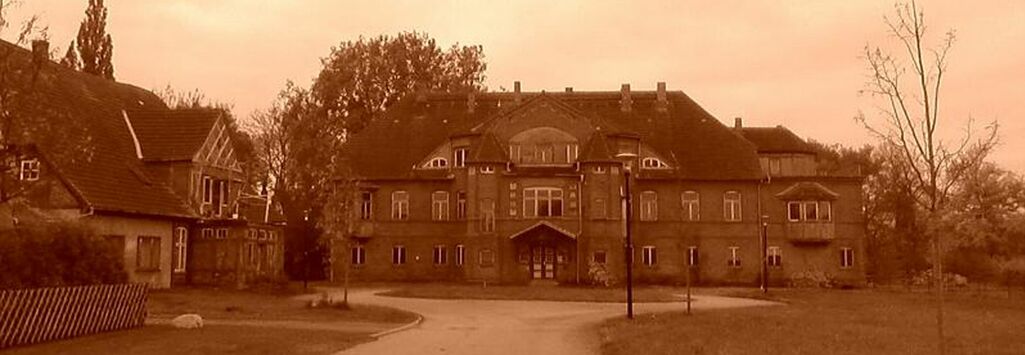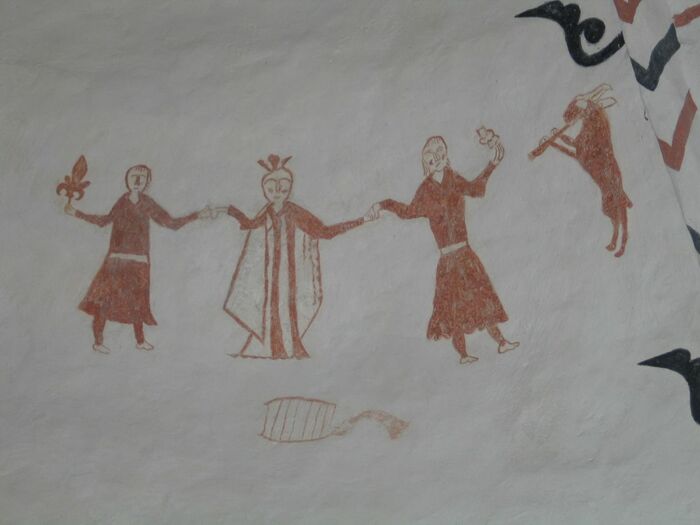Gut Pütnitz History since 1225
contemporary history and stories
Rügenprince Witzlaw 1. gave the estate with the moated castle to the Ratzeburg cathedral chapter, as a thank you for taking in and caring for the prince after he was wounded in an armed conflict near Lübeck.
The first landlords at Pütnitz were the lords of the von Dechow family of knights. The von Dechows received the fiefdom of the Pütnitz estate from Ratzeburg in 1249.
In 1261 the Ratzeburg cathedral chapter sold the village of Pütnitz with the estate for 200 marks to the Knight and Canon of Ratzeburg , Ekkehard von Dechow with the following text translated from Latin ...
1261 - The hereditary feudal village of Putize (Putnitz)
The cathedral chapter of Ratzeburg sells the village of Putize to the Knight Ekkehard von Dechow as a hereditary fief.
Volquart, by the grace of God Praepositus of the Ratzeburg Church, ... we made this decision, and sold the village of Putize close to Ripenize
(Ribnitz) for 200 marks Lübeck and Hamburg coins to the knight Ekkehard called von Dechow with arable land, meadows, pastures and watercourses, also free fishing, ... from the donation of the noble Wiltizlaw, the prince of Rügen, who gave this village to Ekkehard, his wife and his relatives' salvation unreservedly, so that the he and his legitimate heirs recognize that they obtained it from the church to have as fiefdom ...
Ratzeburg in the year of grace 1261
1261 to 1797 - The von Dechow family at Manor Pütnitz
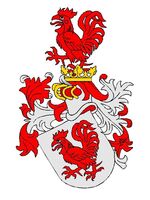
The coat of arms of the von Dechow family
Gottschalk von Dechow, a half-brother of Ekkehard von Hahn, was named as the first knight of Dechow around 1230. Ekkehard von Dechow led the cathedral chapter in Ratzeburg, here is also the connection with the feudal donation of the Pütnitz estate by the cathedral chapter.
After the loan was granted in Ratzeburg in 1261, the von Dechow family moved from the village of Dechow near Ratzeburg / Gadebusch to Pütnitz in Pomerania. The Knights von Dechow built an estate with stables and farms. The farm was characterized by ups and downs in management and was, with the exception of small, insignificant exceptions in the context of “prejudgment attachments” , operated by the von Dechow family until 1797.
The last von Dechow landlord on the Pütnitz estate , Joachim Christoph von Dechow, had a childless marriage. After his death in 1797, he was buried in the family cemetery on the Pütnitz estate. His niece Caroline inherited the estate, because her father, Kart von Dechow, the brother of Joachim Christoph, died as a Hessian major in the war of independence in the USA in 1777.
1797 to 1945 - The von Zanthier family at Pütnitz Manor
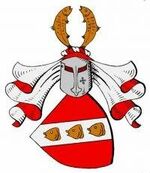
The coat of arms of the von Zanthier family
When Caroline (née von Dechow) married into the von Zanthier family in 1788, after the death of the last landlord Joachim Christoph von Dechow in 1797, the estate was taken over by the von Zanthier family.
Until 1945, the estate on Pütnitz with considerable agricultural and forest areas and small towns (Steinort, Baiershagen, Tempel, etc.) was managed very responsibly by the von Zanthier family .
Hans Dietrich von Zanthier (1856 - 1925) became particularly well-known, who, in addition to his function as landlord, was also a royal Prussian secret councilor, legal knight of the Order of St.John
The construction of the air base on the Pütnitz peninsula from 1935 by the Reichsluftwaffe in the Third Reich was also an economic boom for the Pütnitz estate. Considerable amounts of materials could be delivered for the construction of the airfield. For the transport, the estate at the Recknitz estuary installed a jetty in front of the estate park, where motor less barges with wood and agricultural goods could be loaded and unloaded.
1945 to 1949 - The estate is under Soviet administration
After the Russian invasion in early May 1945, the manor with all its lands and properties was confiscated by the Red Army. Prior to the arrival of the Red Army, the von Zanthier family fled to the west . The majority of all aristocratic families fled as pillaging and raping was common , and aristocrats was very much targeted.
The arrival of the Red Army was followed by looting and destruction of the property of the manor family and their farm workers' families.
Later the manor house was converted for residential purposes and later also for social purposes. The stables were largely preserved and in the following years they were used as farm stables again.
1949 to 1989 - The use of the property in the GDR era
With the founding of the GDR in 1949, the Pütnitz property was handed over to the city of Damgarten (from 1950 Ribnitz-Damgarten).
During the communist rule of the GDR, private ownership of the estate was forbidden . Pütnitz converted into a national “ East German “ estate and as part of the land reform contributed to supply the rural population. The lack of financial means to maintain the stables led to their gradual deteoration.
The manor house was used for various purposes during the GDR era. Immidiately after the war, over 150 refugees from the former East Pomeranian parts of Germany, were housed in the manor house. Later, other than residential purposes, a kindergarten, a school and a local grocery shop were established here. In the caretaker's house, the former manor house and thus one of the oldest houses in Damgarten, a school kitchen was set up.
1989 to 2010 - The city of Ribnitz-Damgarten manages the manor
With the Unification Treaty and the accession of the GDR to the Federal Republic of Germany, a large part of East German the properties, were transferred to the Federal Property Office from 1990 onwards. The administrator's house is sold and a residential area "Am Gutspark" is developed.
The youngest son of the last landlord, Gert von Zanthier, applied for restitution after 1990 to transfer the remaining parts of the estate back, but this was rejected. Gert von Zanthier lived for a short time in the manor house, he was a consultant as an agricultural law expert in the Office for Agriculture in Franzburg until he died in 2006. There was no further attempt by the von Zanthier family to resettle to the manor house on Pütnitz.
In December 2010, the remaining manor house with the park on Pütnitz were sold to the von der Lühe family who had their ancestral home in Kölzow not far from Ribnitz-Damgarten. The von der Lühe family is related to the former estate family von Dechow through marriage in the 13 th centuary.
2010 – Diana and Nikolaus von der Lühe bought the property
The von der Lühe family bought the manor house and the remaining park from the property management company in Ribnitz at the end of 2010. The new landowner, Diana and Nikolaus von der Lühe, began in March 2011 with plans for a reconstruction of the manor house and the manor park in accordance with the preservation of historical monuments. The aim was to preserve and restore as much as possible the old building and to add the necessary changes on the inside of the building - manor house Pütnitz - without any break in historic style.
Gutting of the house started in March , Reconstruction work on the manor house began in October 2011. The architect's office Sebastian Gräwe was entrusted with the planning of the monument preservation and the construction company Lehmann with the execution of the construction. Apart from Polish stucateurs, all trades were done with local companies. The von der Luehe Family employed mr. Wolfgang Peters as the foreman during the reconstruction phase.
In 2012, garden land adjacent to the manor house was leased, so that nothing stood in the way of reconstruction of the manor park.
The manor park has largely maintained its former face with the old stock of trees (e.g. sycamore trees, beech trees, oak trees and other ornamental trees).
The line of sight from the manorhouse and from the grand terraceon the south side of the manorhouse in the direction of the river Recknitz were cut free and a large GDR Coal shed in the park was torn down.
The von der Lühe family has worked close together with the Pomeranian Historical Society : Geschichts- und Heimatverein Damgarten e.V. in the interest of a conservation-oriented design of the remainder of the property and made use of their expertise.
The manor house has been in operation since spring 2013. It is used mainly for vacation rentals in the summer. In the spring and autumn season the Vacation rental apartments, but also the grand ballroom , the fireplace room and the terrace and the old Manor house kitchen are rented for seminars , celebrations and large family gatherings.
Von der Luehe Family
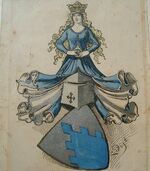
coat of arms
The coat of arms of the Knights von der Lühe shows an ascending five-tinned blue tip. The crest consists of a crowned virgin clad in gold with open golden hair, who holds a golden ring set with a stone in both hands in front of her.
Heraldic saga
Two brothers de Lu, both knights in the service of Henry the Lion, (part of the crusades to Christianize the east) freed a Wendish princess from a burning castle, probably Ilow Castle near Wismar. This castle belonged to the Wenden prince Niklot, as it burned down he fled to his last fortress, Burg Werle, fleeing the troops of Henry the Lion. Both brothers de Lu were enchanted by the beauty of the young princess and desired her. The princess made the choice and gave one brother a bouquet of flowers. The other received a gold ring. He became her husband.
Since then, a crowned princess has adorned the von der Lühe coat of arms. In the coat of arms of the descendants of the brother who married the princess, she is holding a gold ring in her hands. A bouquet of flowers in the coat of arms of the other brother . The von der Lühe family with the bouquet of flowers in their coat of arms died out in the 18th century. The von der Luehe’s living today are all descendants of the knight de Lu, who was chosen as husband by the Wendish princess at that time.
Origin and headquarters
The ancestors of those von der Lühe probably came from Lower Saxony and came to Mecklenburg in the wake of Henry the Lion. The family with Heinrich de Lu is mentioned for the first time in an official document in 1230. The uninterrupted family line begins with Heinrich von der Lühe, who appears in the documents from 1366 onwards.
The ancestral home of the von der Lühe family was Kölzow, near Ribnmitz-Damgarten. The field stone church built in Dettmansdorf-Kölzow next to the ancestral home is one of the oldest churches in Mecklenburg-Western Pomerania. The choir is of Romanesque origin and was consecrated in 1233. In 1987 frescoes from this period were discovered under the plaster and exposed again. One shows a princess with a crown and 2 knights. One is holding the ring, the other is holding a bouquet of flowers.
